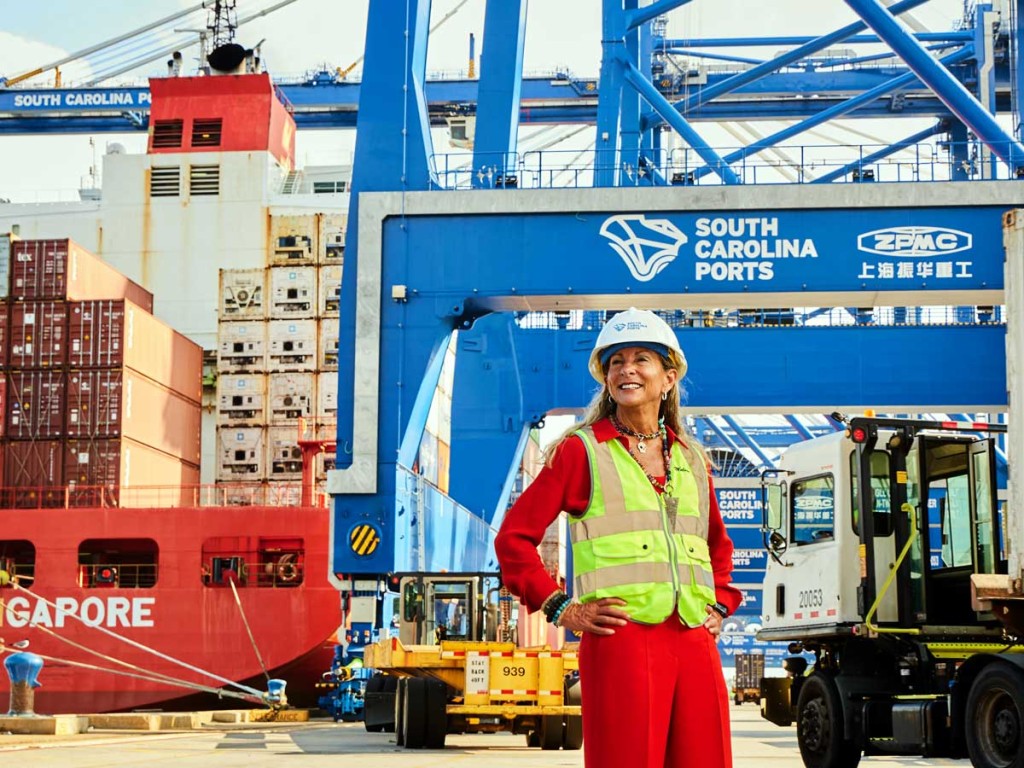With $2 billion in broad-ranging infrastructure investments over the past six years and numerous further enhancements underway, the South Carolina Ports Authority is fluidly moving record cargo volumes while putting in place facilities to accommodate future growth in mega-containership activity.
“Just when you might think $2 billion worth of projects was enough, here we’re coming back with more,” Barbara Melvin, president, and chief executive officer of the South Carolina Ports Authority, told AJOT.

Melvin, who assumed the SC Ports helm in July, capping nearly 25 years with the authority, including the past four as a chief operating officer, is putting her vast port operational experience to spot-on use in ensuring smooth cargo flows through the Port of Charleston today and for decades to come.
In its fiscal year ended June 30, the Port of Charleston enjoyed 12 percent year-over-year growth in containerized cargo volume, reaching 2.85 million 20-foot-equivalent units, or TEUs, solidifying its position as the eighth-busiest U.S. containerport.
“More importantly, particularly for our tapping into retail as well as continuing to support our advanced manufacturing base, is the fact we handled 1.44 million loaded import TEUs, up 22 percent,” Melvin said. “We presented really well as a gateway for imports into the United States.”
She added that, with increasingly large containerships, the port handled nearly 2,500 TEUs per vessel call in the past fiscal year, up 28 percent from the preceding 12-month period.

Melvin said “a holistic investment picture,” involving modernization of longstanding facilities along with construction of new leading-edge infrastructure, has facilitated handling this record growth.
A $550 million update of the 1970s-designed Wando Welch Terminal has brought big-ship-handling capabilities, with the last of 15 new 155-foot-lift-height ship-to-shore cranes erected over the summer. Now three 14,000-TEU-capacity ships can be worked simultaneously.
Meanwhile, the first phase of SC Ports’ Leatherman Terminal – the first new U.S. greenfield terminal since 2009 – is a year and a half into operations with five 169-foot-tall cranes capable of working a 20,000-TEU mega vessel. Two further phases are planned over the next eight years or so at the terminal, which was built on a decommissioned U.S. Navy base site.
And, wrapping up this year, thanks to state and federal funding, is the $600 million Charleston Harbor deepening project, delivering the deepest harbor on the U.S. East Coast at 52 feet at berths and 54 feet along the entrance channel, meaning absolutely no restrictions in any tidal condition for a vessel drawing 48 feet, according to Melvin.
“That’s important not just for our import customers, who are bringing fully laden ships here from Asia and Europe, but it’s also extremely important for our exporters,” she said, noting that outbound cargos include agricultural commodities, forest products, and resins, as well as automotive exports.
Most recently, SC Ports broke ground in mid-October on the $550 million Navy Base Intermodal Facility, about a mile from Leatherman Terminal via dedicated roadway, targeting mid-2025 completion. In partnership with Palmetto Railways, the state-of-industry rail yard is to handle competitive Class I services of CSX and Norfolk Southern. The facility is to be supported by an inner harbor barge operation, advancing on a similar timeframe.
Several additional measures are supporting fluidity, including the designation of a fast-turnaround express berth at Wando Welch Terminal for vessels requiring 1,000 or fewer moves; hiring of 150 more port operations workers; offering of Sunday truck gate hours; and, with a $200 million investment, launching a port-owned and -operated chassis pool that should have more than 13,000 units deployed by next spring.
“Having our inland ports is also a very big advantage for us,” said Melvin, referring to Inland Port Greer, served by Norfolk Southern, and CSX-served Inland Port Dillon. “We are expanding Inland Port Greer within 10 years of opening – and that’s unheard of.”
Expansion of the Greer installation, located 212 miles northwest of Charleston, is adding almost 8,000 more feet of rail tracks plus increasing container yard capacity by 50 percent.
“South Carolina Ports has always differentiated itself in the way it cares for and advances its operational excellence,” Melvin said. “That’s not just from South Carolina Ports Authority employees, but it is the generational impact of our longshoremen, our motor carriers, our stevedores, our tug companies. I mean, you cannot say enough good things when you are luckily located in a port city.
“Our people are our differentiators, and they have been consistent through the generations of our existence,” she added. “We will continue to wildly support our people, and, when I say ‘our people,’ that means the entire maritime community.
“Going forward, what you will continue to see us do is boldly invest in infrastructure,” Melvin said. “When you sit still, your customers don’t know for sure that you can handle their growth. Giving them that confidence allows them to continue to put capital in the ground, not only in South Carolina but through the Southeast.”





